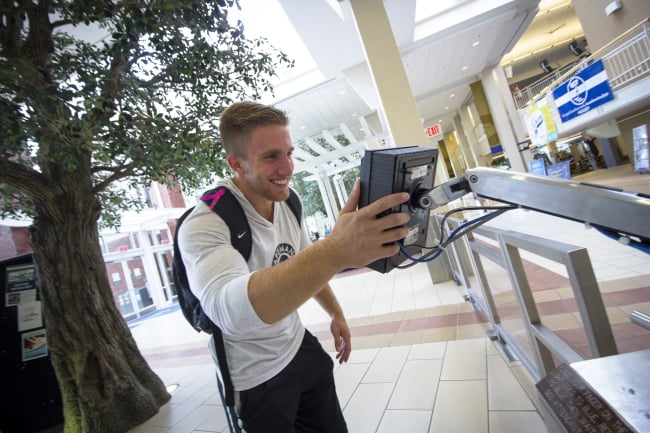You have /5 articles left.
Sign up for a free account or log in.

A student at Georgia Southern U uses an iris camera to access an exercise facility.
Georgia Southern U
The student ID card isn’t going away, but the technologies that colleges are using to supplement it are moving the institutions toward a future in which students are rarely required to pull out their cards.
Requiring students to take out their wallets, pull out an ID and wiggle it just right under a bar-code scanner is a recipe for congestion. Fingerprint or hand geometry reading are some popular alternatives, but the sensors don’t always work on the first attempt, and some students may be squeamish about touching a surface that thousands of other people use -- especially before sitting down to eat.
So the issue remains: How do you get students into the dining hall, recreation center or other spaces on campus quickly while at the same time verifying their identity?
Some institutions, such as the University of Georgia, are pursuing a hands-free future. UGA has used some form of biometric authentication since the 1970s, and this summer will bring the latest development. When students return to campus this fall, they will have the option of enrolling in a system where they can use their irises to enter dining halls and the Ramsey Student Center, said William H. McGee, IT director of auxiliary services at UGA.
The news was first reported by The Red & Black, UGA's student newspaper.
Iris recognition is one of many technologies colleges are considering. Others include low-energy Bluetooth emitters, also known as “beacons,” which can be used to identify students carrying a Bluetooth-enabled device such as a smartphone when they approach them. Near-field communication (NFC) -- which allows devices to connect wirelessly -- initially showed potential, but Apple continues to restrict access to the NFC chip in its iPhone, making it off-limits to developers.
It’s not a coincidence that those technologies can also be found in smartphones, said Richard Wynn, director of Eagle Card services at Georgia Southern University, which has used iris cameras since 2013.
“If we go back a few years ago, biometrics weren’t that well accepted,” Wynn said in an interview. “Smartphones are helping with that.”
In the span of a few years, fingerprinting has gone from being associated with criminal activity to the replacement for the “swipe to unlock” gesture, while iris cameras have become gradually more common. The development has also led to hardware improvements. As smartphone manufacturers have made fingerprint readers and iris cameras basic features of their devices, the demand has challenged companies to develop faster, more accurate sensors.
Bryan Varin, executive director of UGA Dining Services, said in an interview that educating students about the biometric systems has helped dispel myths about what they actually do. He said that, during his 10 years at the university, he has occasionally been approached by students with suspicions about hand geometry or iris recognition, confusing them with advanced fingerprinting and retinal-scan systems.
“These aren’t scanners,” Varin said about hand-geometry readers and iris cameras. “Both of them are simply taking a picture and ending up with a mathematical equation that grants you entry.”
Like at UGA, Georgia Southern students initially expressed some concerns about “the whole Big Brother, 1984 thing,” Wynn said. Iris recognition has since become the preferred way for students to access the dining halls.
Katie Miller, a marketing manager at Georgia Southern, suggested students have embraced iris recognition because today’s 18- to 24-year-olds are such a “noncommunicative demographic” (in other words: “they’re always on their phone”). With iris recognition, all that students need to do is lift their gaze from the screen for a second or two and peer into the camera -- no human interaction required, she said.
Dining and Mining
Iris cameras aren’t yet everywhere at Georgia Southern. Beyond the dining halls, the university has also installed them in a student exercise facility, but to access the library, for example, students still need to bring their physical ID cards.
But data from the dining halls alone already give the university the ability to track when students normally visit those facilities.
“If we have a freshman who’s living on campus and required to have a dining plan, and suddenly we see the student’s not coming in anymore -- what’s going on?” Wynn said. “We can actually alert housing staff and let them know we haven’t seen that student in a while, and they can actually go check on them.”
Wynn took that thought experiment a step farther, imagining a future in which iris cameras are set up across campus -- for example at the entrance of dorms, the library, recreation centers and sports venues. The data collected by students coming and going could give colleges a clear sense of how individual students go about their day, he said.
“In the future, if we decide to go in and mine this data, we have the opportunity to see when or how people ate; if we expand it to other places, when they work out, if they went to the performance art center,” Wynn said.
Such a system could be beneficial from a marketing perspective, Miller said, since it would enable a college to send students targeted information based on their behavior rather than blanket the campus with emails.
Of course, that data would be also highly attractive to companies looking to sell products or services based on student behavior. While the capability to collect data from facilities all across campus is still far from becoming reality, the university is already stressing it has “no plans” to sell data, Wynn said.
McGee and Varin said they have “looked at” the uses for data collected by the biometric authentication systems but that nothing has been decided yet. One immediate use may be to help students pick a meal plan that best matches how often they visit the dining halls, Varin suggested.
At the moment, Varin said, “We are only using this as a means to allow you access into our facilities faster and more accurately.”








